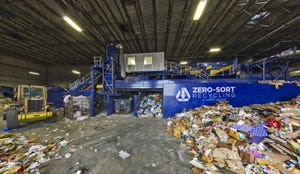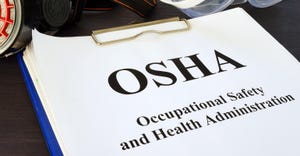New Research Unveiled to Improve Accounting for Non-Hazardous Industrial Waste in the U.S.
Jonathan Krones, postdoctoral associate at Yale University, will debut the final results of his research to improve accounting for NHIW at GWMS.
January 29, 2018
A lot of what we understand from the ancient world comes from looking at waste—that’s what was left behind, says Jonathan Krones, postdoctoral associate at Yale University. Looking at waste is a fascinating way to understand our society. Everyone produces air and water pollution, but only solid waste is something everyone puts their hands on.
In the U.S., however, waste accounting is widely acknowledged to be incomplete. Non-hazardous industrial waste (NHIW) specifically is underexamined to a particularly egregious extent, according to Krones.
At the upcoming Global Waste Management Symposium (GWMS), which is being held at the Hyatt Regency Indian Wells Resort & Space in Indian Wells, Calif., February 11-14, Krones will debut the final results of his research to improve accounting for NHIW.
Waste360: What are some of the main reasons why NHIW is underexamined in the U.S.?
Jonathan Krones: Non-hazardous industrial waste falls into a strange regulatory gap. The waste system in the U.S. is largely defined by federal level regulations. The Resource Conservation and Recovery Act (RCRA) sets standards and rules for both hazardous and non-hazardous wastes, but for various reasons, the latter has primarily focused on municipal solid waste (MSW) collection.
Historically, the focus of waste management has been on environmental protection and sanitation—minimizing the impact on human health. But now, there is a shift at how we look at waste management. There is an increased focus on resource recovery, and there is newfound attention and interest in NHIW because it’s generated in large quantities and has the potential for substituting other materials.
The focus on sanitation rather than resource recovery is one reason why there hasn’t been much attention paid toward maintaining good accounting. This is partially because the risks to human and environmental health of NHIW are comparatively less than that of hazardous wastes and MSW.
Both the generation and the management of this waste happens almost entirely in the private sector, and there hasn’t been the same level of interest or authority in accounting or reporting as there is with many public sector organizations.
There are a lot of waste data gaps, and I’m excited that the Environmental Research & Education Foundation (EREF) has stepped up to fill a lot of those gaps. My research is funded by EREF, and I’m impressed by its work on MSW and landfill systems. EREF is supportive of me and of this work.
Waste360: What are some benefits to accounting for NHIW, and why is it important?
Jonathan Krones: There are some theoretical and practical benefits. In my field—industrial ecology—folks see material systems as a way to understand flows of materials and how everything links together.
On the more theoretical side, understanding the magnitude and nature of material flows better illuminates how our society works and what types of impact on the environment there are.
On the practical side, NHIW is demonstrated to be very useful through the resource recovery of industrial residuals, but it’s challenging for companies to invest in any sort of long-term plan to use those residuals.
With lack of accounting, companies don’t know how much waste, or what kind of NHIW waste, is being generated. Companies also can’t depend on the NHIW product to be consistent over time because the companies might change their processes of how products are made or go out of business or change their raw material input.
Not having a large-scale, robust accounting process inhibits any sort of investment in beneficial uses. But by maintaining an accounting scheme over time, it can enable the emergence of functional markets for these materials that have a real economic benefit.
We’ve seen evidence of this happening. For example, Japan has very real detailed accounting of NHIW, and there have been markets that emerge out of using those materials.
Waste360: Why is it difficult for companies to accurately and efficiently account for NHIW? Do they have the technology to keep up?
Jonathan Krones: Companies often can, but that’s not to say that they all do. Companies are only going to invest in a particular capacity or data collection for something that directly affects what they do.
Companies often don’t have to know what’s exactly in their waste, as long as it’s legally non-hazardous and they know enough to dispose of it properly. Most is disposed of in surface impoundments—giant ponds on factory site—and a lot is flushed out of the factory in process wastewater. Water goes to the pond, solid waste settles and when the water is clean, it is discharged.
Factories will know enough about the waste stream to know it is doing things within the law and operating in the most cost-effective way to manage waste.
Most companies don’t look at their waste stream and say ‘Ah, there is potential revenue there.’ Most want to minimize the cost of how to manage waste, but some folks do look for economic opportunities. There are examples all over, but it’s not done in a systematic way.
In 1985, through a contractor, the U.S. Environmental Protection Agency (EPA) did a survey of companies trying to determine how much waste there is. It called 18,000 factories and asked how much waste they produce, but most of the information the EPA received was about volume of processed wastewater that gets discharged. It didn’t have detailed information on composition and tonnage. And it reported that 6.9 billion metric tons of NHIW is generated per year, but that value has not been updated since.
Things have definitely changed by now. Many companies know how much waste is produced, and it’s now known that the method of calling on all of these factories is very expensive and has a lot of variability. An individual company might be hesitant to share internal information about waste with a researcher if they don’t really know how it will be used or who is involved, so some would want to stay away from reporting to avoid that constraint.
Coal-fired power plants really understand how much waste (coal ash) is generated. Some work really hard to do their own technological innovation to find out new benefits or pathways for materials. Some will do a market push where they do research and development for new uses of their NHIW, and then they’ll go to market and sell this new material. But lots of others don’t.
Waste360: How will this updated information help the waste industry in the future?
Jonathan Krones: It’s unclear exactly which direction it will take. I feel strongly that having a common set of information for people to make decisions around enables creation of effective and efficient markets. It’s something we should do as a whole and people have been getting behind it, but we need to have this shared information in order for everyone to make the best decisions.
I have a couple ideas of how our data might be used. There are organizations like the U.S. Business Council for Sustainable Development that have a program where they will work with stakeholders in a city to do waste matching. If a company is looking for a specific type of waste material to repurpose then they are matched with a provider.
Our data helps enable that activity to happen in more efficient and cost-effective ways. People can go to our database and see the different opportunities. You never really know what people will look at and find value in.
The EPA would also like to adopt methods for accounting as well and all the information would be public.
Waste360: How do you share your findings/methods with companies?
Jonathan Krones: The first time anyone is going to see final results will be at GWMS. I’ve been very cagey about the results, and I want to present it in a way to minimize misunderstanding. It’ll be the first time presented in front of an audience of industry professionals, policymakers and academia.
There will be two follow-ups. The first one is a detailed academic article that lays out my methodology and data sources and justifies it. It goes before academic peer review to see if the method passes muster. Also, my team at Yale and I are working on a series of industry-focused pamphlets that outline results of this accounting process as relevant to them.
Some industries are more receptive than others. The paper industry has done a remarkable job over the last couple of decades in surveying members and understanding its waste. It hasn’t been a priority in recent years, but maybe this will spur the industry to reprioritize solid waste.
A lot of industries might not know what’s going on, so it will be a useful work product for companies to improve their environmental impact or improve their revenue stream.
Waste360: What do you hope GWMS attendees will take away from your presentation?
Jonathan Krones: I hope they learn a little about the importance of waste accounting in general and learn that there are a number of different methods for accessing waste flows and waste accounting. I hope they really see the benefits of developing good accounting schemes for creation of new markets.
You May Also Like


